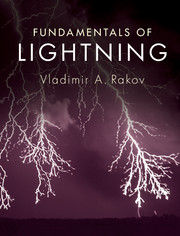Book contents
- Frontmatter
- Dedication
- Contents
- Preface
- 1 Types of lightning discharges and lightning terminology
- 2 Incidence of lightning to areas and structures
- 3 Electrical structure of thunderclouds
- 4 Properties of the downward negative lightning discharge to ground
- 5 Calculation of lightning electromagnetic fields
- 6 Modeling of the lightning return stroke
- 7 Measurement of lightning electric and magnetic fields
- 8 Electromagnetic methods of lightning location
- 9 Lightning damaging effects and protective techniques
- Appendices
- References
- Index
4 - Properties of the downward negative lightning discharge to ground
Published online by Cambridge University Press: 05 April 2016
- Frontmatter
- Dedication
- Contents
- Preface
- 1 Types of lightning discharges and lightning terminology
- 2 Incidence of lightning to areas and structures
- 3 Electrical structure of thunderclouds
- 4 Properties of the downward negative lightning discharge to ground
- 5 Calculation of lightning electromagnetic fields
- 6 Modeling of the lightning return stroke
- 7 Measurement of lightning electric and magnetic fields
- 8 Electromagnetic methods of lightning location
- 9 Lightning damaging effects and protective techniques
- Appendices
- References
- Index
Summary
Downward negative lightning discharges – that is, discharges that are initiated in the cloud, initially develop in an overall downward direction, and transport negative charge to ground – probably account for about 90 percent of all cloud-to-ground discharges. The overall cloud-to-ground lightning discharge, termed a “flash,” is composed of a number of processes, some of which involve channels that emerge from the cloud, while others involve channels that are confined to the cloud volume. Only processes occurring in channels outside the cloud render themselves to optical observations that can be used to determine channel geometry, extension speed, and other pertinent features of those channels. All lightning processes are associated with the motion of charge and, therefore, can be studied via measurement of the electric and magnetic fields associated with that charge motion.
General picture
Basic information about downward negative lightning is given in Section 1.2. In the following, referring to Fig. 4.1, we present a more complete sequence of processes involved in a typical downward negative lightning flash. The source of lightning is usually a cumulonimbus (Chapter 3), whose idealized charge structure is shown in Fig. 4.1 as three vertically stacked regions labeled “P” and “LP” for main positive and lower positive charge regions, respectively, and “N” for main negative charge region. The stepped leader is preceded by an in-cloud process called the preliminary or initial breakdown. It may be a discharge bridging the main negative and the lower positive charge regions, as shown in Fig. 4.1 (see also Section 3.5). The initial breakdown serves to provide conditions for the formation of the stepped leader. The latter is a negatively charged plasma channel extending toward the ground at an average speed of 2 × 105 m s−1 in a series of discrete steps. From high-speed time-resolved photographs, each step is typically 1 µs in duration and tens of meters in length, with the time interval between steps being 20 to 50 µs. The peak value of the current pulse associated with an individual step has been inferred to be 1 kA or greater. The stepped leader serves to form a conducting path or channel between the cloud charge region and ground. Several coulombs of negative charge are distributed along this path, including downward branches.
- Type
- Chapter
- Information
- Fundamentals of Lightning , pp. 52 - 114Publisher: Cambridge University PressPrint publication year: 2016
- 1
- Cited by



